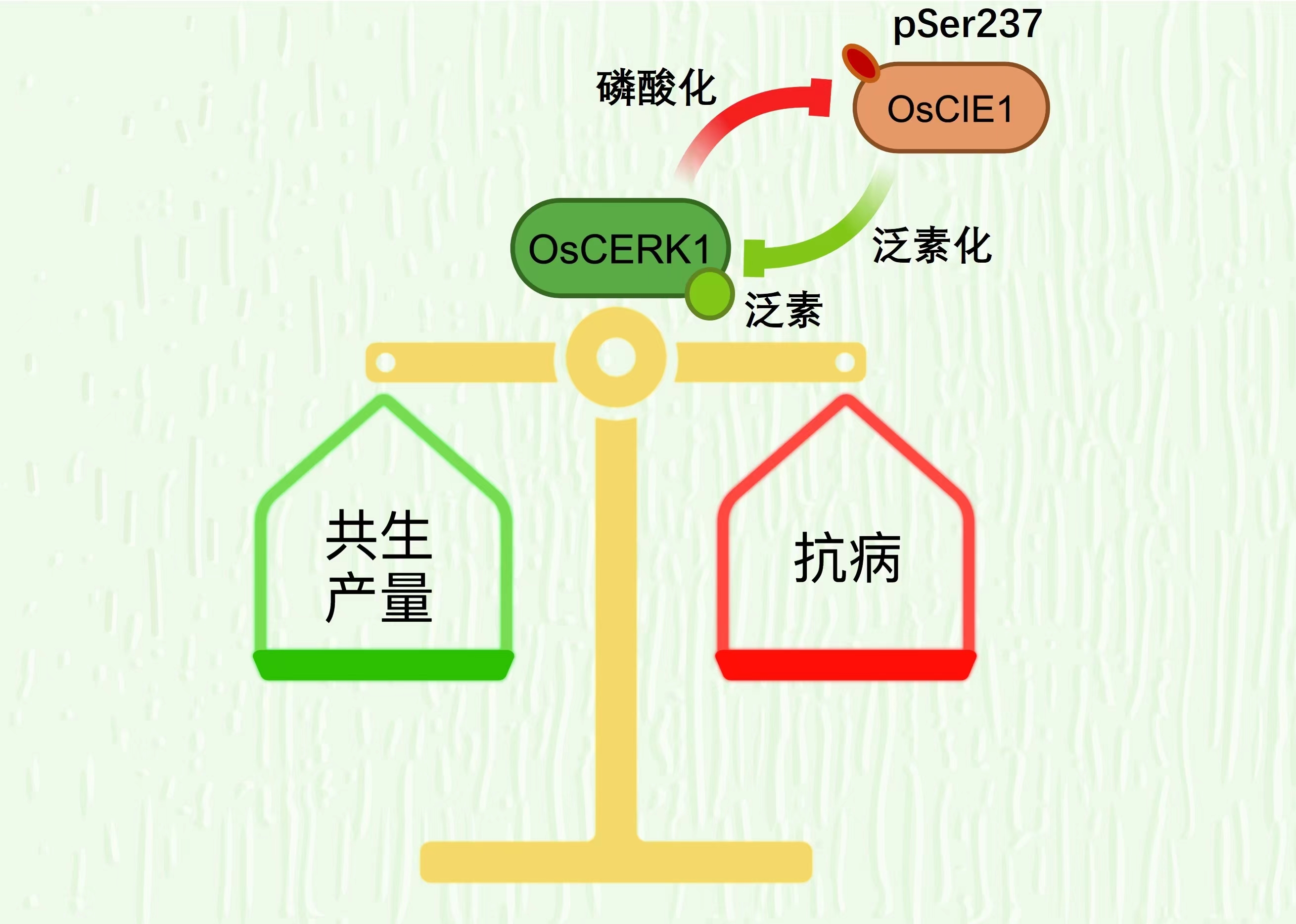

Schematic diagram of the mechanism by which OsCIE1-mediated ubiquitin protein "brake" regulates OsCERK1 co-production/immunity balance.
In addition to fertilizers and genes, are there any other ways to increase rice production?
Scientists from China are trying to use microbial approaches, such as mycorrhizal symbiosis, like soybeans with rhizobia.
He Zuhua, an academician of the Chinese Academy of Sciences, said that the rapid growth of bamboo shoots after the rain is also related to the symbiosis of microorganisms.
It is worth noting that although they are all fungi, some can coexist with rice and increase rice production, while others can make rice "sick" and reduce production.
Just as an excessive immune response in the human body can cause harm to the body, an overactivated immune response in rice can also hinder its growth and the establishment of mycorrhizal symbiosis.
How does rice effectively regulate immune responses that may become overactivated?
In other words, how does it "brake" its own immune response?
For a long time, this has been a mystery that has yet to be solved in the scientific research community.
On May 15, Beijing time, Wang Ertao's team, Zhang Yu's team and Academician He Zuhua's team from the Center for Excellence in Molecular Plant Sciences of the Chinese Academy of Sciences made a major breakthrough in the research on rice immune mechanisms.
'A double-edged sword'
Through genetics, structural biology and other methods, the researchers analyzed the regulatory details of the structure and activity of OsCERK1, a key receptor protein on the surface of rice cells.
The protein can recognize immune signals or symbiotic signals and specifically mediate the symbiotic or immune response of plants. The researchers found that a regulatory protein called OsCIE1 can bind the kinase activity of OsCERK1.
This research result not only clarifies the molecular mechanism of plant coordinated regulation of immunity, symbiosis and growth and development, but also provides genetic resources for future green agricultural production.
Currently, this achievement is being tested in 10,000 mu of rice fields by promoting mycorrhizal symbiosis and improving rice's disease resistance. In the future, it is expected to be applied to increasing production and income of crops such as corn and wheat.
The result was published in the top international academic journal Nature under the title "Release of a ubiquitin brake activates OsCERK1-triggered immunity in rice", laying a theoretical foundation for a deeper understanding of how plants cleverly use the double-edged sword of the immune system to coordinate the balance of disease resistance, symbiosis and growth.
How to break through
However, the process of overcoming the above scientific problems is full of hardships.
When asked about the biggest challenge, co-first authors Postdoctoral Fellow Wang Gang and Dr. Chen Xi said, “It’s the pattern.”
"Others said 1+1=2, but we found out that 1+1 is not equal to 2. However, we had to find evidence to prove 1+1=2 again," they said.
For a long time, people believed that ubiquitination meant that a protein was going to be degraded. However, postdoctoral fellow Wang Gang and Dr. Chen Xi could not find the phenomenon of OsCERK1 protein being degraded in their experiments.
"For about two years, we were stuck at this step," said researcher Wang Ertao.
"Others drew a template, and I thought about how to do it and how to adapt to it. At that time, we didn't have the courage to challenge it," said Dr. Wang Gang and Dr. Chen Xi.
Then, once they break free from this constraint, the problem is solved.
"We analyzed the phosphorylation site of this protein and found that it is conserved across species. Not only in rice, but also in humans, zebras, fish and fruit flies, it is very conserved. In fruit flies, it even affects the length of lifespan," said Postdoctoral Fellow Wang Gang and Dr. Chen Xi.
As for the future, researcher Wang Ertao described a dream - the dream of green agricultural development driven by microorganisms.
He said, "Our ultimate ideal situation is that the above-ground part of crops is very disease-resistant, so that the use of pesticides can be reduced. The underground part of crops can coexist with microorganisms to help plants obtain nutrients from the environment. In fact, we can also optimize these microorganisms to promote their interaction with plants. The development of green agriculture in the future will be driven by microorganisms. This is the scenario we hope to see in the next 5 to 10 years or 10 to 20 years."
For the above-mentioned scientific research results completed by the joint efforts of three research groups, how was the research breakthrough achieved?
Academician He Zuhua believes that "one reason is that we have the best scientific researchers; the second is that our institute has such an atmosphere - multidisciplinary cross-cutting, support, and cooperation, which is our characteristic and culture." "We are doing basic research, and our goal is to meet national needs."
Han Bin, an academician of the Chinese Academy of Sciences, concluded that, first, there must be good scientific questions; second, before young scientists become famous, institutions and governments should pay more attention to them and provide more support. Including Wang Ertao, young scientists at the Center for Excellence in Molecular Plant Sciences of the Chinese Academy of Sciences are very active. "The culture of the Chinese Academy of Sciences is to strongly support young people's scientific research work within ten years."
